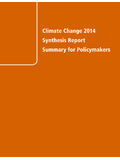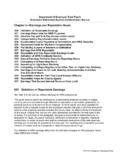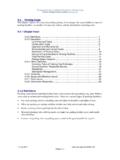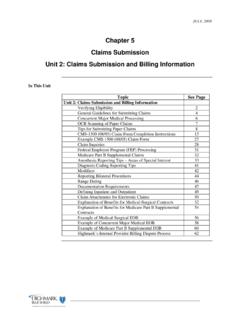Transcription of Chapter 7 Education - WHO
1 Chapter 7 Education I joined a mainstream school near my house for easy access. Although I could go to school on my wheelchair and could go back home with ease if any need arose, there was not any type of accessibility within the school. There were stairs everywhere and no access to classes by any other means. The best thing that could be done was to place my classroom on first floor which meant that I had 15 steps to conquer to get into or out of my class. This was usually done by having two people carry me up and down everyday. To make things really worse there were no accessible toilets. This meant that I either had not to use the toilet the whole day or go back home and lose my classes for the day.
2 Heba I am 10 years old. I go to a regular school; I am in the 4th grade. We have a wonder-ful teacher, and she does everything to make me feel comfortable. I use a wheelchair to get around and have a special desk and a special wheelchair at school. When there was no eleva-tor in the school, my mother helped me to go up the stairs. Now there is an elevator, and I can go up by myself and I like it a lot. We also have a teacher who uses a wheelchair, just like me. Olga [Being in an inclusive school] makes us learn how we can help each other and also understand that Education is for everybody. In my former school both pupils and teach-ers used to laugh at me when I failed to say something, since I couldn t pronounce words properly and they wouldn t let me talk.
3 But in this school if students laugh at me, teachers stop them and they ask forgiveness. Pauline I did not have formal Education . There just wasn t facilities. It didn t make me feel good. But I can t do much about that now. I just stayed at home. I was more or les self taught. I can read and articulate myself quite well. But the opportunities I would have wanted never occurred, so I was only able to reach a certain level, I could not get any further. Ideally I would have gone to university, studied history. James By the time I reached Standard 6, I d lost almost all of my sight. My dad didn t want me to go to school once I was completely blind I think he was afraid for me but an NGO convinced him to let me continue.
4 After I graduated primary school my father was happy for me to continue on to high school. The NGO provided the funding for my four years of high school and they helped me with my cane, a Brailler, books, like Richard I want to go to school because I want to learn, and I want to be educated, and I want to define my life, to be independent, to be strong, and also to live my life and be happy. Mia 7 EducationEstimates for the number of children (0 14 years) living with disabilities range between 93 million (1, 2) and 150 million (3). Many children and adults with disabilities have historically been excluded from mainstream Education opportunities.
5 In most countries early efforts at providing Education or train-ing were generally through separate special schools, usually targeting specific impairments, such as schools for the blind. These institutions reached only a small proportion of those in need and were not cost-effective: usually in urban areas, they tended to isolate individuals from their families and com-munities (4). The situation began to change only when legislation started to require including children with disabilities in educational systems (5).Ensuring that children with disabilities receive good quality Education in an inclusive environment should be a priority of all countries.
6 The United Nations Convention on the Rights of Persons with Disabilities (CRPD) rec-ognizes the right of all children with disabilities both to be included in the general Education systems and to receive the individual support they require (see B ox ). Systemic change to remove barriers and provide reasonable accommodation and support services is required to ensure that children with disabilities are not excluded from mainstream educational inclusion of children and adults with disabilities in Education is important for four main reasons. Education contributes to human capital formation and is thus a key determinant of personal well-being and welfare.
7 Excluding children with disabilities from educational and employment opportunities has high social and economic costs. For example, adults with disabilities tend to be poorer than those without disabilities, but Education weakens this association (8). Countries cannot achieve Education for All or the Millennium Development Goal of universal completion of primary Education with-out ensuring access to Education for children with disabilities (9). Countries that are signatories to the CRPD cannot fulfil their responsi-bilities under Article 24 (see B ox ).For children with disabilities, as for all children, Education is vital in itself but also instrumental for participating in employment and other areas of social activity.
8 In some cultures, attending school is part of becoming a complete person. Social relations can change the status of people with 205206 World report on disability disabilities in society and affirm their rights (10). For children who are not disabled, con-tact with children with a disability in an inclu-sive setting can, over the longer term, increase familiarity and reduce prejudice. Inclusive edu-cation is thus central in promoting inclusive and equitable focus of this Chapter is on the inclu-sion of learners with disabilities in the con-text of quality Education for All a global movement that aims to meet the learning needs of all children, youth, and adults by 2015 and on the systemic and institutional transformation needed to facilitate inclusive participation and children with disabilityIn general, children with disabilities are less likely to start school and have lower rates of staying and being promoted in school (8.)
9 11). The correlations for both children and adults between low educational outcomes and having a disability is often stronger than the correla-tions between low educational outcome and other characteristics such as gender, rural residence, and low economic status (8).Respondents with disability in the Worl d Health Survey experience significantly lower rates of primary school completion and fewer mean years of Education than respondents with-out disability (see Ta b l e ). For all 51 countries in the analysis, of males with disability have completed primary school, compared with of males without disability.
10 Females with disability report primary school comple-tion compared with of females without disability. Mean years of Education are similarly lower for persons with disability compared with persons without disability (males: versus years respectively; females: versus years respectively). In addition, Education com-pletion gaps are found across all age groups and are statistically significant for both sub-samples of low-income and high-income to country-specific examples, evidence shows young people with disabilities are less likely to be in school than their peers without disabilities (8).

















